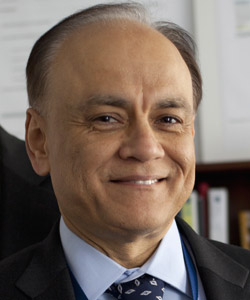In collaboration with CHIME, Becker's Hospital Review'snew "Life of a Healthcare CIO" series features leading hospital and health system CIOs from across the country who are sharing their experiences, best practices and challenges.
To recommend a CIO to be featured in this series, please contact Helen Gregg (hgregg@beckershealthcare.com).
An interview with Kumar Chatani, senior vice president and CIO of Mount Sinai Health System in New York City. (Interview has been edited for length and clarity.)
Question: You've been CIO of Mount Sinai for two years. How has your job changed since you began?
Kumar Chatani: When I started at Mount Sinai, we had two hospitals and a School of Medicine. Now we have grown to seven hospitals, a School of Medicine, a School of Nursing and an accountable care organization. So my responsibilities have more than doubled. I had a 400-person team, now I have 800 people, and my budget has more than doubled to $250 million
My job has taken on a whole new breadth — from a CIO of two hospitals and a medical school, to where I am the corporate CIO for all seven hospitals with new structure in place for site level IT directors. It has been a very exciting time for me.
Q: In your time with Mount Sinai, what has been your biggest accomplishment?
KC: My biggest accomplishment, and what I am most proud of, is building a strong leadership team. We were able to handle the combination [with New York City-based Continuum Health Partners] and deliver on all the key programs the health system needed. Our IT department has had a spectacular year.
Q: What do you see as your biggest misstep or mistake?
KC: Looking back, I have made mistakes in not terminating vendors who were not performing. There was one situation where I should have pulled the plug on the vendor sooner, but it's always 20/20 hindsight to see what you should have done a year earlier.
Q: Looking back over the past month, what has taken up the majority of your time?
KC: Our combination with Continuum Health Partners was announced on Sept. 30, 2013, so for the last 60 or 70 days everything has been about integrating multiple hospital systems. We have to integrate the systems and IT teams who have to support these systems. All of this has taken up most of my time. Our business partners deserve speed and performance from IT. We have to integrate our teams really fast so we are not the bottleneck in realizing the benefits of the combination.
Q: What is the biggest challenge you're facing right now?
KC: We have two different organizations coming together, and they both have different legacy systems and priorities and infrastructures. When we combine them, we have this large health system where people will be moving back and forth. I have to make everything work seamlessly — and everyone wants it done tomorrow. It's a challenge but it's also an opportunity because it's so exciting to be doing something massive like this under a tight deadline.
Q: What is one lesson you've learned during your tenure you'd like to share with other CIOs?
KC: Hire a strong IT leadership team and delegate effectively. Between the hospitals, clinics, the School and the accountable care organization, I oversee the IT function for over hundred sites. I cannot do it all by myself. I need to have a strong leadership team to delegate to so I can focus on the more strategic work.
Health IT is such an exciting field, and we are in a sweet spot right now. We, as IT professionals, can make a huge difference to our patients, providers and staff members. It's a great opportunity for our profession right now. We must rise to the occasion!
More Articles in the "Life of a Healthcare CIO" Series:
The Life of a Healthcare CIO: Spectrum Health's Patrick O'Hare
The Life of a Healthcare CIO: KishHealth System's Heath Bell
The Life of a Healthcare CIO: Mt. San Rafael Hospital's Michael John Archuleta

